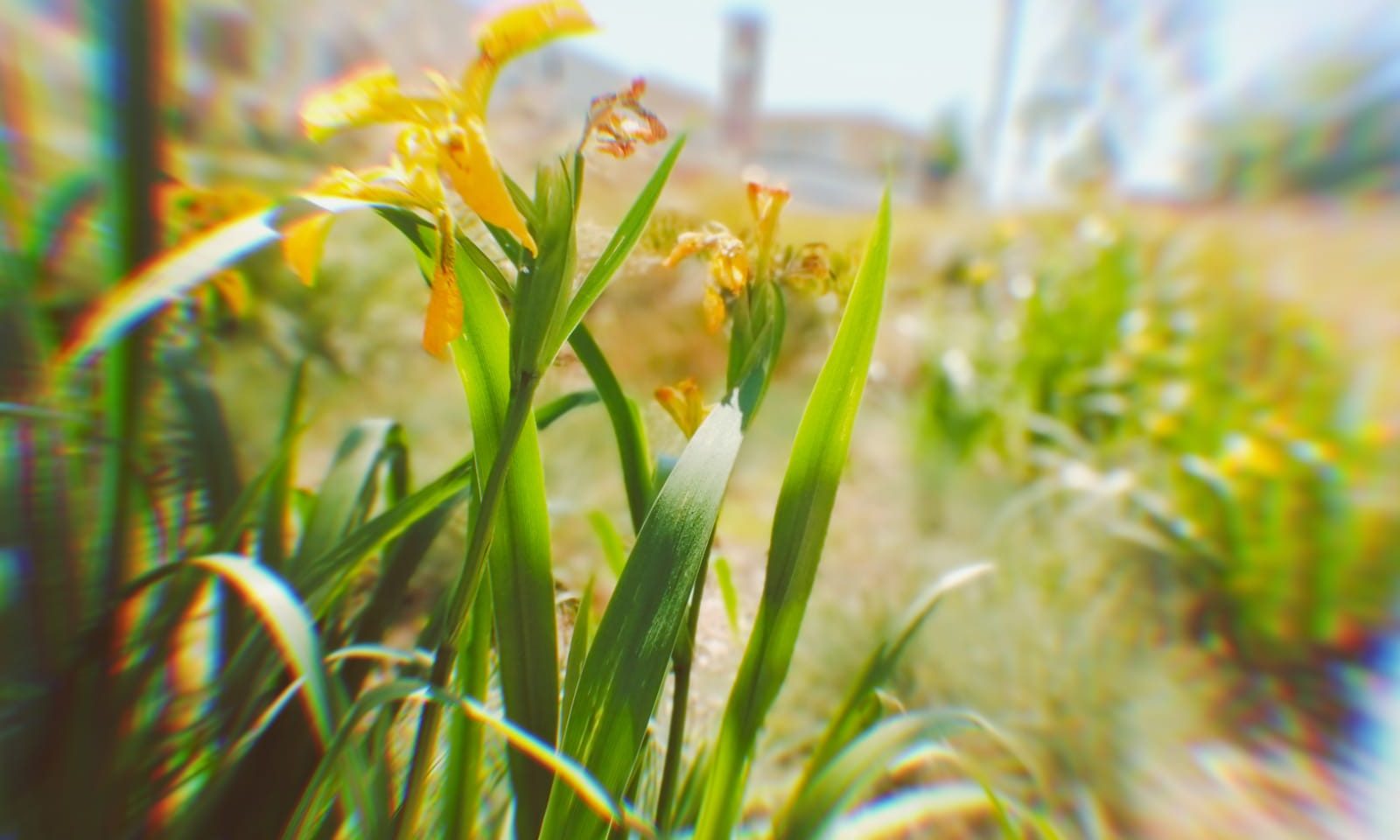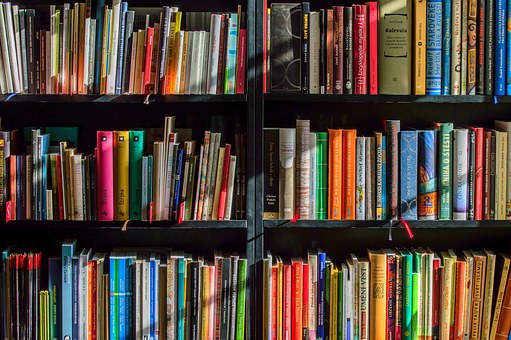Monday Moments: Invisible Colours
Introduced by Holly King
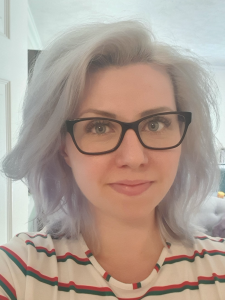
Did you know that the human eye can see approximately one million colours? Colour is such a basic element of our lives; it dictates when we should ‘go’ or ‘stop’, whether someone has poured too much milk in your tea and there are even colour personality tests you can take at work (based on Hartman’s Personality Profile). Yet no two people see the same colour.
We see colour in hue (red, yellow, green, blue), saturation (deepness of that colour, e.g. pastel vs bold) and brightness (how the colour radiates or reflects light). Colour or full blindness, synaesthesia (the involuntary mixing of senses, so someone might hear colour), tetrachromacy (a select few of us can see more colours than anyone else), the species we belong to; they all make a difference in how we experience colour. So really, each one of us sees a different world.
What about the colours we don’t see? Colours are associated with every type of feeling, but they’re not ‘real’. We don’t actually see someone turn green with envy, or become blue when sad, yet these are synonymous with emotions and conjure vivid pictures in our minds.
I take away three things from this. The first, is that every single living thing on this earth is looking at something different, experiencing the world in a different way. If 100 people are viewing the same flower, but each see a different colour (even marginally), is there a ‘right’ or ‘wrong’ answer? Or is the answer that you’re all experiencing something, seeing something, and how you see bases how you interact with and navigate the world? Therefore, how can any person or set of people be right over another? It’s just their way of viewing the world, and the processes involved in ‘seeing’ are far more complex and ‘science-y’ than we think, anyway, so we’re all wrong – or all right!
The second, is to be patient and kind to others. What they see may not be as simple (can you imagine getting to a gender reveal party and seeing the balloons come out as a shade of grey rather than pink? Perhaps you have Protan colour blindness), or they may not be able to see anything at all and ask you to describe it (how do you describe a colour to a blind person? I’d use other senses). Just because you may see something as obvious or straightforward doesn’t mean everyone else will. As we’ve just learnt, if everyone views the world differently, learning to see things from other perspectives can only be beneficial.
The third, is to be happy! This means you’re unique by default; how you see the world is one way that no one else can ever truly match. So, although Stanley Kubrick may have said: “Everything has already been done. Every story has been told” (he does go on to say we should “do it one better”), I’m going to have to disagree and say, whatever story you have to tell hasn’t been told yet; not in the way you can tell it, at least. So, pick up that pen and get creative!
*****
I have some vibrant, passionate and mind-blowing features for you this week. The first is from Patsy Middleton, who gives a powerful message on our theme of ‘Invisible Colours’:
The colour of a person’s skin should be invisible if we love our fellow man.
The colour of a vagrant’s tattered clothes should also be invisible – there is a person wearing them.
The colours of flags ought not make us hate those who do not wave the same banner.
Countless colours are invisible to many people because their eyes, though open do not see. Life’s daily burdens dulls their perception.
Don’t let the colours of life be invisible. Step your thoughts away from the mundane and look around you.
Nature’s colours surround us yet who has seen the full magnificence of daybreak?
A smudge of purple divides dark sea and sky, heralding the dawn. The streak turns orange and spreads like spilled liquid across the horizon. Soon it is yellow against the azure sky and a new day has begun.
Most people sleep through this daily miracle, dawn’s colours invisible to them.
When sun shines through raindrops a rainbow appears to amaze and delight those with eyes looking upward.
And who, in spring, has looked towards treetops and seen bright new filigree leaves bursting forth. Not many. They miss this breath-taking beauty.
But the most beautiful invisible colours shine in a person’s eyes:
The glisten of sympathetic tears. The sparkle of elation when they see another’s achievements. The light of understanding a sad person’s pain.
The bright empathy for those living around them.
(C) Pasty Middleton, 2020
COLOURS
Speak of mermaids and the deep blue sea
surprised by a bolt from the blue.
Be a bluestocking or a blue-jay bird
dining cordon bleu.
Make it a date with a blue-collar man
and a blue-blooded fellow, or two.
Paint the town red and be a red devil,
red in tooth and claw.
Wave a red flag and hear a bull bellow.
Put a red herring at the door.
Cut the red tape or be in the red
wearing red shoes like a whore.
While shrinking violets barely trust,
Monarchs turn purple and fume.
Deep purple shadows fall with the night
Purple clouds scud past the moon.
Lavender’s perfume calms a sad heart
Likewise, a harpist’s tune.
Far from these things is a whiter shade of pale
like moody nights in white Satin.
Bing went white Christmas, all in a dream
And a dinosaur rode a white swan
while Swift on white horses atop of the wave
no sooner arose then was gone.
You can use more colours when painting life:
we haven’t gone green for the planet.
Nor have we seen pink elephants drunk
or been shot with a silver bullet.
Now when you’re browned off or in a grey mood
write rainbow-songs with your word palette.
(C) Pasty Middleton, 2020
*****
Next, we have artist Emmanuel Oreyeni with an illustration your eye is immediately drawn to. He tells us:
“No matter where we are, there’s always some colour we can’t see, but which makes up the colours we do see.
You have the three primary colours. These are the colours that can make up any other colour in the colour spectrum. For example, to make green, you need to mix an even amount of yellow and blue. This creates a secondary colour. No matter the colour, their origin is from either all of those three colours, or two. Secondary colours are made from primary colours; for example, orange is a secondary colour, as it is made from two primary colours: red and yellow.
When these colours are mixed well, they make one colour, meaning you don’t see two colours, just one. They blend in and become invisible to make another colour. As an artist, I’m trained to make colours exist by mixing different primary and secondary colours to get the right colour or skin tone – depending on what I’m painting. I don’t need to use a lot of one colour to mix it with another to get the colour I desire, but I can use a mix that also changes the opacity of the colour to create layers, instead of trying to make one colour all in one go.
White light is an example of invisible colour, as it is a balance of a collection of bright colours. For example, when there is water in a glass cup, a ray of sunlight will show you rainbow. How cool is that! Hopefully, in my drawing below and with the help of a few filters, you can see colours you may not have first thought you had seen .”
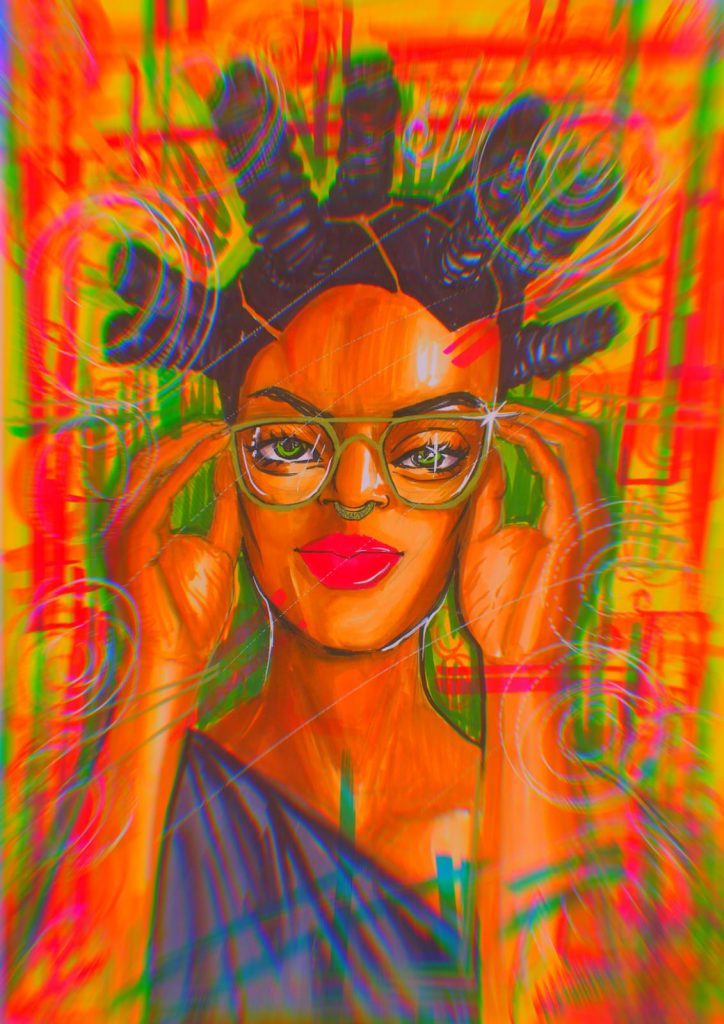
Emmanuel is also showcasing the photograph he took ( see below). Having played with filters, he enhances certain colours while reducing others. This shows how what we see can be altered and enhanced by technology, to show us colours we wouldn’t perhaps have noticed before.
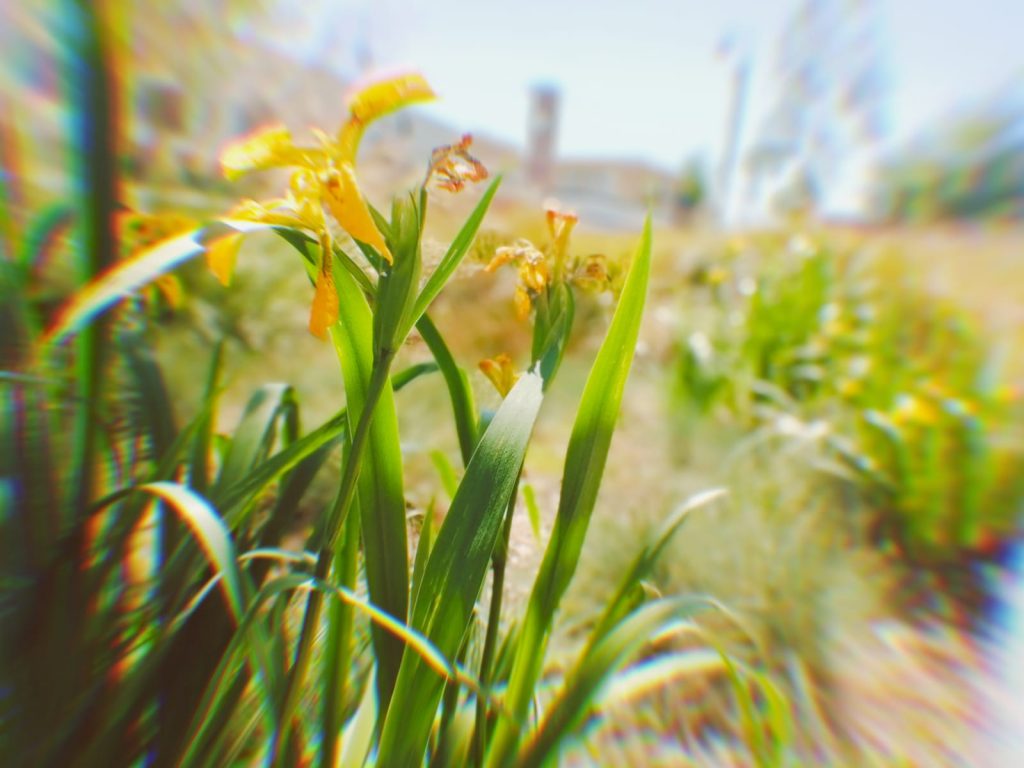
Connect with Emmanuel on Instagram: @oreyeni.arts, Twitter: @artsoreyeni and follow him on YouTube: Oreyeni Arts
Learn to draw sessions every Monday at five pm on Zoom: https://zoom.us/j/516550777
*****
Lastly, we have a fascinating feature from Michelle Sutton, who showcases the knowledge she’s gained from working at the Natural History Museum around how other species view the world:
Invisible Colours Of Nature
As humans, we miss out on a lot. Flowers are pretty and colourful to us, but to insects they show an array of hidden patterns and colours due to their ability to see ultraviolet (UV) light. And they’re not the only ones. So can birds and spiders, and new research suggests a wide range of mammals can, including cats.
There are numerous examples of ‘invisible’ colour in nature. Structural coloration is one of my favourites. I worked in the Natural History Museum’s butterfly house for several years and often talked about this with regards to a particular species: the blue morpho (Morpho peleides). It appears metallic or iridescent blue; however, it’s not. Its colour is not pigment but is created by the alignment of its scales refracting light. If it’s shiny in nature, it’s probably because of light. Which is why I like asking people: What colour is a kingfisher?
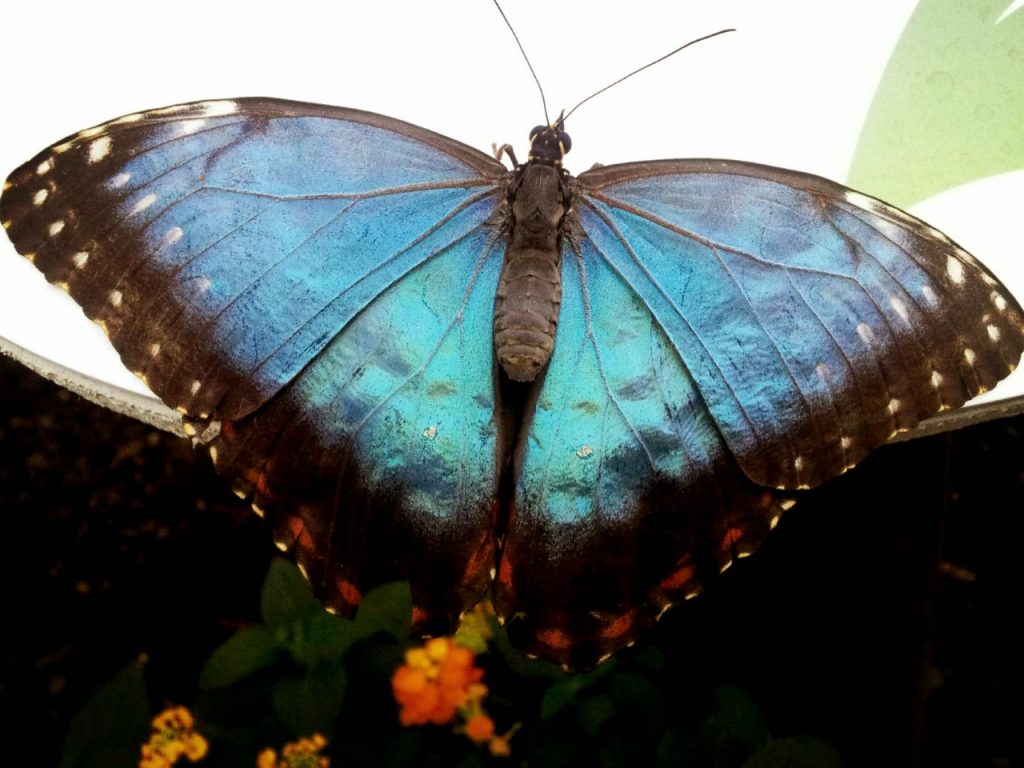
Other examples that spring to mind exist underwater. Ever wondered why in nature programmes featuring the deep sea, a lot of the creatures are red? This is because red light has the longest wavelength but the least energy in the visible spectrum, which means it doesn’t penetrate well through water. So, red appears black with no red light to reflect at those depths. This means the creature is nearly impossible to see. Good for both predator and prey!
I’m sure you’ve heard of bioluminescence: light created inside the bodies of certain creatures, giving them the ability to glow and glitter in complete darkness. My favourite example of this is an animal I recently drew, called the Bobtail Squid. Their bioluminescence is produced by host bacteria that live in their underbellies. It’s a symbiotic relationship: in exchange for food, the bacteria emit blue light, which helps the squid with camouflage.
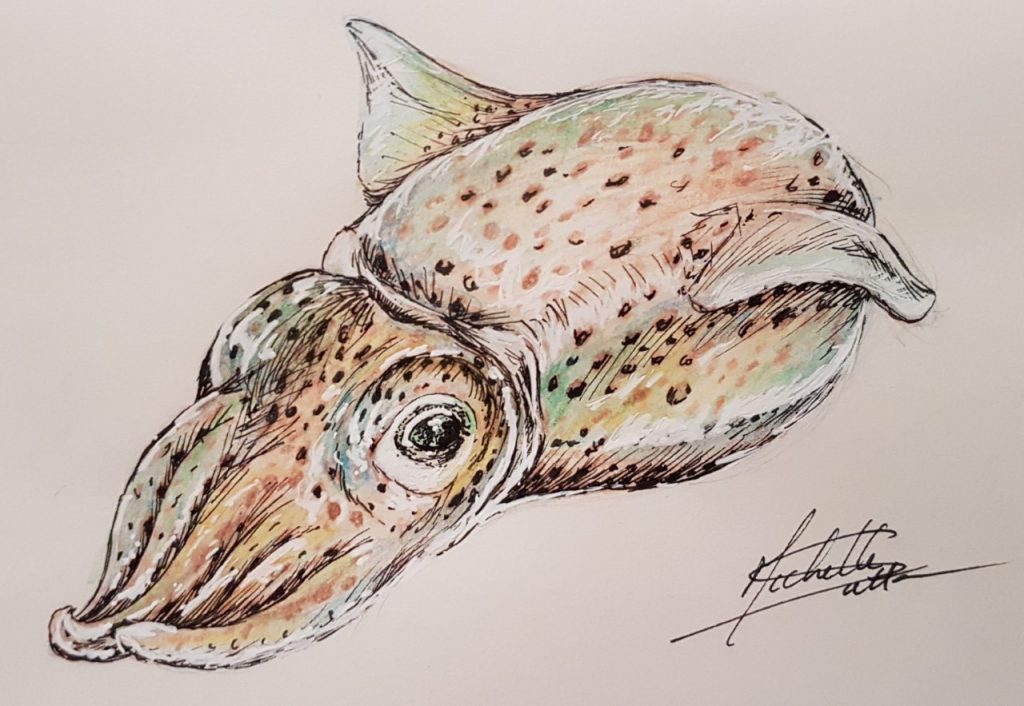
These are the main examples I could think of off the top of my head, but to get a better idea of the vast scope, I posted a message on Facebook to ask my friends and colleagues at the Natural History Museum for more. It didn’t take long for the replies to come in, so I shall leave you with some of them:
Mantis shrimps and their expanded ability to see colours: Mantis shrimps have 12 different types of colour photoreceptors. A human has three.
Voles’ urine is their downfall: Voles use urine to help them navigate and communicate with one another. Unfortunately, their urine is visible in UV light and kestrels use this to hunt them.
Fly bioluminescence: Many flies emit bioluminescence, including Keroplatidae. There are some very famous caves in New Zealand (the Waitomo Glowworm Caves) which are a vast tourist attraction.
Bioluminescent worms: David Attenborough’s Life That Glows featured bioluminescent earthworms found in the Loire Valley in France, but there is also a species in the UK that produces bioluminescence, Microscolex phosphoreus. It emits a greenish glow when disturbed and is believed to be a defence mechanism.
Colourful Trees: The pigments in deciduous tree leaves aren’t usually visible until the chlorophyll breaks down. Which is why we get such an array of autumnal colours.
Spider vision: Jumping spiders (Salticidae) can see just like humans using trichromatic vision and are also able to see in the UV spectrum.
Plants are bioluminescent too: Coralline algae have stacked photo-pigments. Each one extracts energy from a specific range of wavelengths. The filtered light passes into the next stack of pigments, which extracts energy from those wavelengths and so on. It’s an incredibly efficient system. The top of the plant has a crystalline cap that helps focus the light down the tube as well.
*****
ReadFest is going Digital this year. Check out our 2020 programme and book your FREE tickets online: https://pentoprint.org/readfest/
And – don’t forget, Issue 5 of Write On! magazine is available to read online, just click here!
Just because you may see something as obvious or straightforward doesn’t mean everyone else will. As we’ve just learnt, if everyone views the world differently, learning to see things from other perspectives can only be beneficial.


